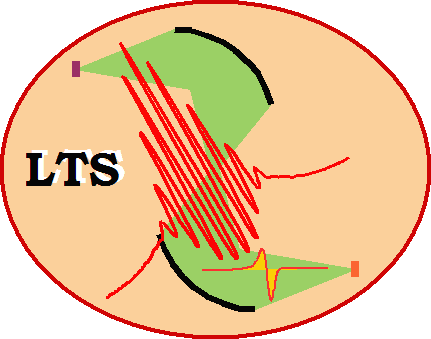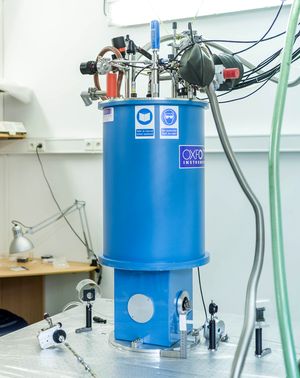
THz science and technology
Equipment
Contents
- Setups for time-domain terahertz spectroscopy
- Laser sources
- Spitfire ACE regenerative femtosecond amplifier
- TOPAS parametric amplifier
- VITESSE femtosecond oscillator
- MIRA femtosecond oscillator
- Further equipment
Setups for time-domain terahertz spectroscopy
Optical pump – THz probe setup based on laser amplifier
Our custom-made setup is driven by the femtosecond SPITFIRE laser amplifier (800 nm, 40 fs, 1 mJ, 5 kHz). Coherent THz pulses are generated via an optical rectification (difference frequency mixing) in a 1 mm thick ⟨110⟩-oriented ZnTe crystal and a phase-sensitive detection is accomplished via electro-optic sampling in another ZnTe crystal with the same characteristics. The spectral range spans from ∼0.2 THz to 2.5 THz.
Samples may be photoexcitated using the fundamental beam or its harmonics (800 nm, 400 nm, or 267 nm), which is suitable for tasks where high pulse energy and high stability of the photoexcitation is required. Alternatively, an optical parameteric amplifier (TOPAS) may photoexcite the sample at any wavelength in the range 240 – 3000 nm.
The setup is suitable for transmission measurements of samples in steady state (solids, liquids). It can be equipped with a cryostat or a furnace, permitting measurements in the temperature range 10 – 900 K. The room-temperature and low-temperature measurements also permit application of high voltage up to 1.5 kV. The THz beam path is enclosed in a vacuum chamber to prevent absorption of the THz beam on water vapor.
Characteristics of the THz pulses
| Peak electric field | 5 kV/cm |
| Average power | 0.7 µW |
| Energy per pulse | 0.7 nJ |
| Peak power | 2.3 kW |
| Photons per pulse | ~7×1011 |

Fig. 1.
Photo of the setup for optical pump – THz probe spectroscopy.
Multi-THz spectroscopy
This custom-made setup is also driven by the femtosecond SPITFIRE laser amplifier (800 nm, 40 fs, 1 mJ, 5 kHz). Coherent THz pulses are generated using two-color plasma and sensed using air-biased coherent detection. The spectral range spans typicall from 2 THz to 20 THz (to be checked).
Samples may be photoexcitated using the fundamental beam or its harmonics (800 nm, 400 nm, or 267 nm).
The setup is suitable for transmission measurements of solid samples. Application of high voltage up to 1.5 kV is possible. The THz beam path is enclosed in a chamber purged with dry air to prevent absorption of the THz beam on water vapor and to enhance the stability of the setup.
Characteristics of the multi-THz pulses (to be estimated)
| Peak electric field | 120 kV/cm |
| Average power | --- |
| Energy per pulse | --- |
| Peak power | --- |
| Photons per pulse | --- |

Fig. 2.
Photo of the setup for multi-THz spectroscopy.
THz spectrosopy in a magnetic field up to 7 T
Our custom-made setup is driven by the femtosecond oscillator VITESSE (800 nm, <100 fs, 80 MHz). Coherent THz pulses are generated in an interdigited biased photoconducting antenna (TeraSED) and a phase-sensitive detection is accomplished via electro-optic sampling in a ⟨110⟩-oriented ZnTe crystal. The spectral range spans from 0.1 THz to ∼2.8 THz.
The setup is suitable for transmission measurements of solid sample both in Faraday and Voigt geometry in magnetic fields up to ±7 T. The available temperature range spans from 1.8 to 270 K (temperatures exceeding 220 K can be applied only for a limited time interval).

Fig. 3.
Photo of the setup for THz spectroscopy in high magnetic fields.
Near-field THz spectrosopy (SNOM)
Terahertz near-field scanning optical microscope from Neaspec is now available in our laboratory. The operation spectral range is 0.5 – 2.0 THz, and the spatial resolution is 50 nm.
Standard THz spectroscopy
This custom-made setup is driven by the femtosecond laser oscillator MIRA (800 nm, 50 – 80 fs, 76 MHz). Coherent THz pulses are generated in an interdigited biased photoconducting antenna (TeraSED) and a phase-sensitive detection is accomplished via electro-optic sampling in a ⟨110⟩-oriented ZnTe crystal. The spectral range spans from ∼0.2 THz to ∼3.0 THz.
The setup is optimized for rapid accurate measurements of dielectric properties of solid and liquid samples in transmission geometry. It can be equipped with a cryostat or a furnace, permitting measurements in the temperature range 10 – 900 K. The room-temperature and low-temperature measurements also permit application of high voltage up to 1.5 kV. The THz beam path is enclosed in a vacuum chamber to prevent absorption of the THz beam on water vapor.
Characteristics of the THz pulses
| Peak electric field | 0.1 kV/cm |
| Average power | 0.27 mW |
| Energy per pulse | 3.5 pJ |
| Peak power | 0.27 kW |
| Photons per pulse | ~1.4×1010 |
Laser sources
Spitfire ACE regenerative femtosecond amplifier
The Spitfire ACE regenerative amplifier is typically used for optical pump – THz probe experiments and/or for pumping the optical parametric amplifier (TOPAS).
| Manufacturer | Spectra-Physics/Newport |
| Pump laser | Empower Q-switched Nd:YLF laser, 45 W |
| Seed laser | MaiTai SP |
| Mean wavelength | 800 nm |
| Pulse length | 35 fs (adjustable) |
| Repetition rate | 5 kHz |
| Energy per pulse | 1 mJ |
| Photons per pulse | ~4×1015 |
| Average power | 5 W |
| Pulse peak power | 28 GW |
MIRA femtosecond oscillator
Mira is typically used for time-domain THz transmission spectroscopy in the steady state.
| Manufacturer | Coherent Inc. |
| Mean wavelength | 800 nm |
| Pulse length | 50 – 80 fs (adjustable) |
| Spectral bandwidth | 15 – 40 nm |
| Repetition rate | 76 MHz |
| Energy per pulse | 8 nJ |
| Photons per pulse | ~3.5×1010 |
| Average power | 650 mW |
| Pulse peak power | 140 kW |
VITESSE femtosecond oscillator
The Vitesse system is used in conjunction with the magnetic cryostat.
| Manufacturer | Coherent |
| Pump laser | Verdi 4.5W |
| Mean wavelength | 800 nm |
| Spectral bandwidth | 10 – 15 nm |
| Repetition rate | 80 MHz |
| Energy per pulse | 11 nJ |
| Average power | 1 W |
TOPAS parametric amplifier
The TOPAS parametric amplifier (TOPAS = travelling-wave optical parametric amplifier of super-fluorescence) is typically used for photoexcitation in optical pump – THz probe experiments.
| Manufacturer | Light Conversion |
| Tuning range | 240 – 3000 nm |
| Pulse length | ~50 fs |
| Energy per pulse | 1 – 100 µJ (depending on the output wavelength) |
Further equipment
- Lock-in amplifier Stanford Research 830 DSP
- Boxcar averager Stanford 850
- Tilted Front Pulse Autocorrelator (TFPA) from Light Conversion
- APE-mini autocorrelator
- Spectrometer Acton Spectra Pro® 150
- Cryostat Oxford Optistat CF from Oxford Instruments, adapted for THz spectroscopy, temperature range 5 – 300 K
- High temperature cell adapted for THz spectroscopy from Specac, temperature range 300 – 1000 K

